 image by M.C., 3 October 2001
image by M.C., 3 October 2001
FOTW beschäftigt sich mit der Wissenschaft der Vexillologie (Flaggenkunde).
Alle auf dieser Website dargebotenen Abbildungen dienen ausschließlich der Informationsvermittlung im Sinne der Flaggenkunde.
Wir distanziert uns ausdrücklich von allen hierauf dargestellten Symbolen verfassungsfeindlicher Organisationen.
Last modified: 2021-08-24 by rob raeside
Keywords: italy | politics | padania | po | savoy | lega nord | northern league | lega piemontese | lega liguria | lega lombarda | insubria |
Links: FOTW homepage |
search |
disclaimer and copyright |
write us |
mirrors
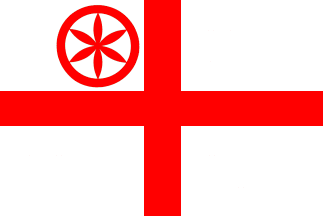 image by M.C., 3 October 2001
image by M.C., 3 October 2001
Alternate Flag
See also:
Padania is a geographic name of the valley formed by river Po
(Padus in Latin IIRC), that is the most part of Northern Italy.
Italy is divided into Regions: Padania is more or less composed
of Lombardia, Piemonte, Liguria,
Veneto, Emilia (half of Region Emilia-Romagna).
Giuseppe Bottasini, 13 May 1996
The green "Sun of the Alps" is the symbol of
Padania, according to its proponents. The most used flag is just
a white banner of these arms, but sometimes the "Sun"
is put on the canton of the red-cross-on-white flag of Milan.
Alessio Bragadini
Silver charged with green Sun of the Alps in center. Ratio
1:2. Six petals in a circle, four arranged as St. Andrew's cross,
two vertically. the "Federal Republic of Padania" has
been announced on Sunday, September 15th 1996 in Venice, by
Umberto Bossi, founder and leader of 'Northern League for
(seeking) the Independence of Padania', during a 3-days
pro-independence manifestation. The 'Sun of the Alps' or
'Independence Flag' had been presented by Parliamentarian Roberto
Maroni on Sept 11th, officialized by Padanian
"institutions" afterwards.
From: "Official Padanian Gazette", Sunday 15th September
1996.
M.C., 3 October 2001 (translated by Manuel
Giorgini)
The flag of Padania is only a mere invention of the "Lega
Lombarda" party in the late '90s, and it has no historical
precedents or roots: the flag represents a green centered sun in
a white field. The name "Padania" has always been used
with geographical meanings, until the Leghisti (belonging to the
Lega Lombarda party) used it to intend a sort of "Northern
Italian nation" (which, of course, does not and never
existed).
Fabio Facoetti, 26 October 2003
Someone says it was created taking inspiration from the flag
of an association about Brigasque culture. See web.tiscali.it.
However, I don't know what's the origin of that Brigasque flag.
Paolo Montanelli, 4 July 2003
The Alternate Flag represent the so-called
"Bandiera Storica della Nazione Padana" (The Historical
Flag of Padania Nation). It derives from the graphic fusion of
St. George flag, the flag of "Resurrection", that
has a very important use in Padanian heraldry, and "Sole
delle Alpi" (Sun of the Alps), the symbol of the
Celtic heritage of this land. The flag is now used by the
associations that support the idea of cultural,
ethnic, socio-political and linguistical independence
of Padania (La Libera Compagnia Padana, Ass.ne Cult. Terra
Insubre, etc.) and by Lega Nord.
M.C., 25 September 2000
Silver background with red cross, charged with a red Sun of
The Alps in canton (first quadrant).Proportions 2:3 (more or
less), but in most cases 95 cm x 130 cm . The Cross of St. George
is a first order partition, [though some heraldic authors argue
that the cross [throughout] is not a partition but a charge],
formed by a combination of the pale (vertical stripe) and the
fess (horizontal stripe), using two of the noblest heraldic
colours: Silver, white 'metal', memory of the old plate-mails of
noble knights (the other heraldic metal is 'gold', kept for
high-ranked knights and for the Rulers) [Argent and Or,
heraldically. Both heraldic metals indeed, as opposed to colours,
both of them tinctures], and the red colour, considered as the
first colour for Arms, representing the shed blood [Please note
that all these colour symbolisms are a bit of a concoction...].
The Historical Flag of Padania comes as a join between the St.
George's Cross and the Sun of the Alps, both red in colour. The
St. George's Cross relates to the Crusades. It has always been
used as their own symbol by the Lombard Crusaders in the Holy
Land; then adopted by the English and French (for a short time),
and more generally by anyone not having their own symbol. Legend
says that the cross has been used by the Roman Emperor
Constantinus I The Great (...) as well. During a battle against
Massentius, near the Roman Milvio Bridge in 312 d.C., he saw a
flaming cross in the sky with a circular saying, 'in hoc signo
vinces' (in this mark you will win), which he adopted on a white
field as a vexillum for his Militia and himself. The following
year the Emperors Constantinus and Licionius (?), in Mediolanum
(Milan), will grant freedom of religious choice in the Empire.
During another Crusade hundreds of years later, another legend
says, a Divine Event happens again in 1098, during the Antiochia
Siege. St. George appears to the crusaders; around him stand
angels carrying the flag in question. Since then, the red cross
on a white field has always been related to St. George the
Winner, who might be a Christianized version of the old gods
Wotan (Germanic), or Taranis (Celtic), or even Mithra
(Hindo-European). According to Harold Barleym, its name might
come from GE=earth and URGE=rule, so as in 'he who rules the
earth', the power to control the telluric(?) forces
(earthquakes), symbolized by the Dragon. Somebody even proposed
St. George as Patron of Padania along with the Madonna of Urupa.
Identified as 'Vexillum Sancti Petri' (St. Peter's Flag), the
flag is also called 'Resurrection Flag'; bonded to Christ's
Resurrection, who will vanquish the anti-Christ while standing
before the Church of St. George in Lyddha, according to the
tradition. The Crossed symbol has always been a common sign for
all Padanian peoples and specifically lumbards. It flew over the
taken walls of Jerusalem in 1096, when the Lumbard crusaders,
first among all, entered the holy city leaded by John of Rho; it
had been chosen as symbol of Cremonese League (Pontida, April 7th
1176) and of Societas Lombardiae (the first glorious Lombard
League, born in Pontida on May 29th 1176 on a treaty between the
Cremonese and Veronese leagues). It also appeared on the Republic
of Genoa's flags and coats of arms used by the Republic of Venice; part
of the People's Gonfalone of the Republic of Florence (kept after
it became part of the Great Duchy of Tuscany); used by the Duchy
of Massa, in Emilia, in Romagna and counts 125 appearances in
signs of Communes from Padania to Istria, from Tirol to Tuscany
(among which Milan-Milano, Ivreya-Ivrea, 'Alba-Alba,
Varséi-Vercelli, Portu Murisiu, Arbénga-Albenga, Lek-Lecco,
Mantua-Mantova, Chignoo-Chignolo Po, Padova-Padova,
Bulagna-Bologna, Rez-Reggio nell'Emilia, Rémin-Rimini....). The
proposed federal constitution, called 'Constitution of federal
Padanian union', determines in its 18th article: UFP's seal is the
Sun of the Alps, made by six petals arranged within a circle; its
land flag is the Sun of the Alps, Veneto-Celtic green in colour,
on a white field; its sea flag is a join between St. George's and
St. Mark's standards. Its historical flag is St. George's cross,
(loaded) with a red Sun of the Alps in the canton. (first
quadrant).
Information partly provided by:
Gilberto Oneto, Bandiere di Liberta, Effedieffe, 1992;
Gilberto Oneto, L'invenzione della Padania, Foedus Ed., 1997;
M.C., 3 October 2001 (translated by Manuel
Giorgini) and Santiago Dotor, 13 November 2001
How about an "honorable ordinary?" English
blazon distinguishes between ordinaries, subordinaries, and other
charges, so ordinary would maybe correspond to "piece of the
first order." Just a guess.
Joe McMillan, 13 November 2001
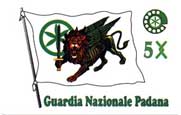
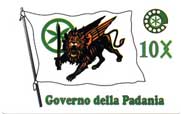
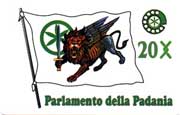 from space.tin.it
from space.tin.it
About two years ago in an article by Massimo Bonini in Flag Report, there
were published a lot of Padanian flags. Three of them I found now in the web in space.tin.it. Even
if the three flags seems to be same, there are some differences
between them that is hard to see in the images at the Internet.
At www.granbaol.org
there is a Padanian flag in the background bearing the map of
North and central Italia in light green. The flags of
North League and Padania are hoisted below.
Jaume Ollé, 1 September 2002
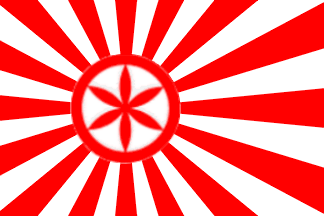 image contributed by Marco Lambruschi, 21 October 2005
image contributed by Marco Lambruschi, 21 October 2005
I've found at www.bandieredeipopoli.com
this rather unusual "Padania flag" - a Japanese war
ensign with the Alps Sun instead the red disc.
Marco Lambruschi, 21 October 2005
At the mentioned website there are other strange flags (beside
some well-known and well-documented ones), for instance the well-known
Padanian flag, but with added inscription "Padania
libera" or the collage
of "Padanian" flags. Although the Lega Nord has
been by far the most vexilliferous political organization in
Italy in the 90ies, I have never actually seen evidence for
several of these flags. These seem to me computer graphics, but
never actually flown as flags. Especially the "Japanese war
ensign" type is certainly to strange to miss.
M. Schmöger, 1 November 2005
Is there any historical precedent for Padania? I mean, have
these areas ever been united in the past? Is this, for instance,
the traditional boundary of Savoy, or am I thinking of some
completely different part of Italy? I realize that Italy was a
series of smaller independent or semi-independent states as
recently as the middle of last century. Where did the name
Padania come from?
James Dignan, 19 September 1996
What about the Cisalpine Republic (which, as I recall, was
formed by merging the Cispadane and Transpadane Republics...
before Napoleon changed it to "the Italian Republic" ?
Will Linden, 19 September 1996
Much earlier, the old Lombard Kingdom of Italy in the early
middle ages centered on Pavia occupied the Italian peninsula
north of the old Papal States. It didn't include Venice or
Ravenna, though.
Josh Fruhlinger, 19 September 1996
Traditionally, the Duchy of Savoy was located on the Western
part of the Alps. It is now a part of France. Napoleon III helped
the Italians fighting for their unity against the Austrians. As a
thank you, the Italian leader Cavour proposed to give to France
Savoy and the county of Nice (which had joined the Savoie Duchy
in 1388). Elections were organized and people massively voted for
becoming French, in 1860 IIRC. Savoy was split into two
departments : Haute-Savoie (capital: Annecy) and Savoie (in the
South, capital Chambery, the historical capital of Savoy). Of
course, this is the history as we learn it in France. Maybe our
Italian friends will have an other view on that question ! IIRC
my classical studies, Padanius (?) was the Latin name for the Po
river, which is considered by Bossi as the emblem of the 'new'
country'. For the moment, Bossi does not revindicate the French
Savoie...
Ivan Sache, 20 September 1996
'Padus' is the Latin name of the Po river. Geographically the
northern part of Italy is called 'Val Padana' (Padana Valley) and
'padano' is the adjective related to it, e.g. 'grana padano' is a
kind of cheese produced in Val Padana. 'Padania' is derived from
'padano' and should mean 'the country of Padanians'. The
secessionist movement claims that Padania also includes many
regions (Toscana, Romagna, Liguria and Süd Tirol) which are not
parts of Val Padana; they call 'Padania' all the northern and
northern-centre regions, i.e. the "richest" part of
Italy. The real cause of the secessionists is not cultural or
ethnic but economic: to separate the richer North from the poorer
South.
Giuseppe Bottasini, 20 September 1996
The word "Padania" has been common in geography and
social studies from the 60's to describe the area around the Po
river. Note that it usually did not comprehend the Veneto region
and all Northern-Eastern Part of Italy, whereas the Leghisti usually
think Veneto belongs to Padania (and they referred sometimes to
Venice as "Padania Capital city").
From a linguistic point of view, the regions of Northern Italy
(from Piedmont to Romagna, excluding Trentino, Veneto and Friuli)
belong to the Gallo-Italic dialect group, which could be
considered for some aspects more similar to French than to Tuscan
or other Southern-Central Italian dialects. This, of course, does
not imply that a "Gallo-Italic" or "Padanian"
nation undoubtedly exists: some linguists think that every region
dialect should be considered a different "language"
(due to mutual unintelligibility and phonetic and lexical
peculiarities) so there should be at least five
"Gallo-Italic languages" (or probably seven) and so
maybe five" (or seven) "potential nations"...
Paolo Montanelli, 4 July 2003
Hosted by: Fanshop-Online.de und Handy-Shop.de
Tipp: Apple iPhone 12 im Shop